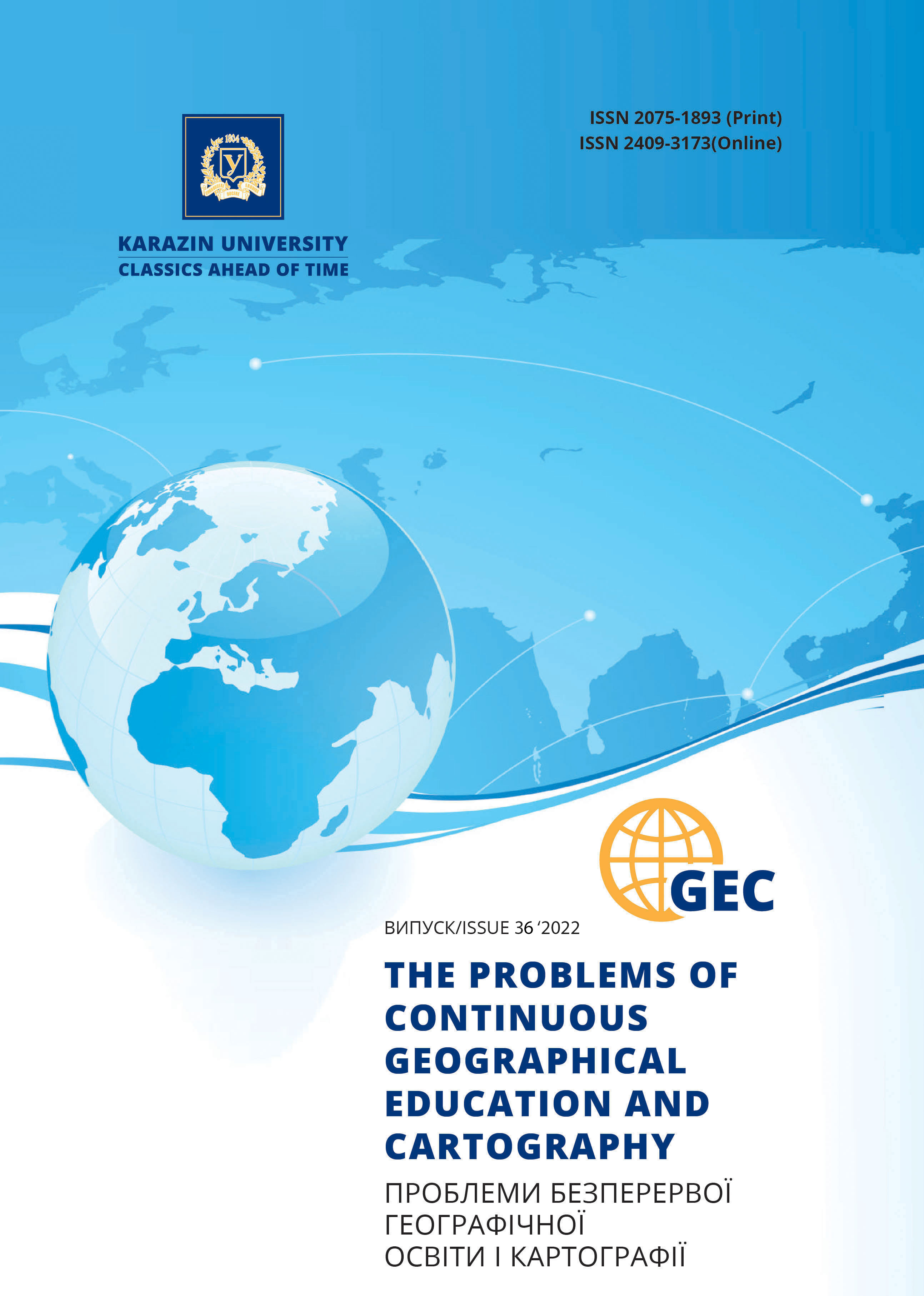The concept of noospheric ecosystems as the theoretical basis for monitoring studies of roadside landscapes
Abstract
The purpose of the article. Considering the growing expansion of man in relation to nature, we should include the support (or violation) of the biosphere’s ability to self-reproduction as one of the most important criteria in all classifications and typologies of landscapes, ecosystems, geosystems, types of human activity.
The main material. We implement this general criterion at the level of ecosystems of different species and spatial levels. Thus, we theoretically approach to the selection of anthropogenic landscapes (including linear ones), considering the priorities of ecosystem dynamics. The problem indicated in the title is primarily the result of constant density growth of the transport network, and, therefore, the ever-increasing “theft” of natural ecosystems by humans from aboriginal plants and animals. The main feature of the study in highly developed countries is the priority of preserving ecosystem dynamics during the construction and operation of highways. The solution to this problem, for example, in the USA today, is in the development of a practical guide for companies engaged in road construction. Based on such priorities, we should pay attention to the following quantitative and qualitative parameters of road landscapes that can affect the dynamics of infra-ecosystems: the species composition of plant communities, which can be an indicator of individual impacts of roads. For example, the presence of halophyte plants will help to fight against icing with salts or insufficient soil washing regime. The presence of invasive plants affects the intensity of the transfer of their seeds by vehicles or birds; the presence of hydrophyte plants, which may indicate insufficient drainage of the road surface, etc. External manifestations of the vital activity of animals on the roadside territories can help to assess the completeness of ecosystem relations in infra-ecosystems, signs of disruption of ecosystem dynamics by the road surface. In our opinion, the concept of noospheric ecosystems, of which infra-ecosystems (or road) are a part, can satisfy the indicated requirements for the highway monitoring research program. Road landscapes are an integral part of the transport infrastructure, from which the name “infra-ecosystem” actually originates. However, we consider natural (natural, natural-anthropogenic) processes in landscape-engineering and landscape-technogenic systems that are fully controlled by humans, as common features that determine road landscapes. They are extremely important for our research, as these systems are not capable of independent development, but manifest it only in their individual components.
For example, artificially planted shrubs, trees, or sown grasses along the road surface are supplemented with plants characteristic of this natural zone over time, forming even certain plant groups.
Conclusions. Monitoring research programs should answer the following main questions:
- How do the infraecosystems differ from the natural ecosystems of the area? In particular, assessment of all (or some types of impact): soil composition, hydrological regime, phyto- and zoo diversity, dustiness, noise pollution, radiation background, etc.
- How has this infraecosystem adapted to the conditions of anthropogenic impact (changes in the species composition of plants and animals, the formation of new trophic relationships, etc.)?
- What needs to be done to minimize the negative impact of transport activities on the new ecosystem, environmentally adapted infrastructure.
Downloads
References
Adamova, H.V. (2021) Comprehensive ecological and analytical assessment of the system «car – road – environment» on the example of the road section m-29. Bulletin of V.N. Karazin Kharkiv National University. Series «Ecology», 2021, issue. 25. DOI: https://doi. org/10.26565/1992-4259-2021-25-05 [in Ukrainian].
Smaliychuk, A. (2012). Theoretical and conceptual foundations for the study of anthropogenic dynamics of geoecosystems. Series: geography. Special Issue. – Ternopil: SMP “Type”, 2 (32). 113-117 [in Ukrainian].
Grodzinsky, M.D. (2005). Cognition of the Landscape: Place and Space. [Monograph in 2 vols.]. Kyiv: Publishing and Printing Center «Kyiv University», 1, 431; 2, 503 [in Ukrainian].
Denysyk, G.I., Valchuk-Orkusha, O.M. (2017) Classification and optimization of road landscapes. International Scientific and Practical Conference “WORLD SCIENCE”, 8(24), 2 [in Ukrainian].
Didukh, Ya.P. (2012). Problems of correlation between some key concepts in ecosystemology. Biotopes (habitats) of Ukraine: sci-entific principles of their research and practical results of inventory. (Materials of the workshop. Kyiv, March 21-22, 2012.). Edited by Ya.P. Didukh, O.O. Kagal, B.G. Prots. – Kyiv-Lviv, 194 [in Ukrainian].
Ecological Foundations of Balanced Nature Management in the Agricultural Sphere: Textbook. Edited by S.P. Sonko and N.V. Maksymenko (2015). Kharkiv: V.N. Karazin Kharkiv National University, 568. (Educational and scientific series “Ecologist’s Library” [in Ukrainian].
Kruglov, I. (2016). Basic Geoecosystem (B-HPP) as an integrating object of transdisciplinary geoecology. Scientific Notes of Ternopil Volodymyr Hnatiuk National Pedagogical University. Series: geography. - Ternopil: SMP “Type”, 2 (41) [in Ukrainian].
Andrus, K. The Great Meadow Appears on the Surface: The Story of the Legendary Hylaea, Her Death, and “Resurrection.” Available at: https://nikopol.nikopolnews.net/ukraina/velykyj-luh-ziavliaietsia/ [in Ukrainian].
Cultural Landscape as a Geographical Phenomenon: Materials of the International. Sciences. Conf. (September 23–25, 2021). – Chernivtsi: Chernivtsi nats. Univ., 2021, 140 [in English].
Denysyk, H., Kanskyi, V., Kanska, V., Denysyk, B. (2022). Anthropogenic landscapes of Ukraine and their reconstruction. Czasopismo Geograficzne, 93(3), 417–433. https://doi.org/10.12657/czageo-93-16 [in English].
Sheng-Lan, Zeng, Ting-Ting, Zhang, Yu, Gao, Bin, Zhao (2011). Effects of road age and distance on plant biodiversity: A case study in the Yellow River Delta of China. Plant Ecology, Follow journal, 212(7), 1213-1229, February 2011. DOI: 10.1007/s11258-011-9899-x [in English].
Sonko, S. (2019). Man in Noosphere: Evolution and Further Development. Philosophy and Cosmology. The Academic Journal. Kyiv, 22, 51-75. DOI: https://doi.org/10.29202/phil-cosm/22/5 [in English].
Wildlife crossing structure handbook design and evaluation in North America. Chapter 2 - Wildlife populations and road corridor intersections. Available at: https://www.fhwa.dot.gov/clas/ctip/wildlife_crossing_structures/ch_2.aspx [in English].

This work is licensed under a Creative Commons Attribution 4.0 International License.





